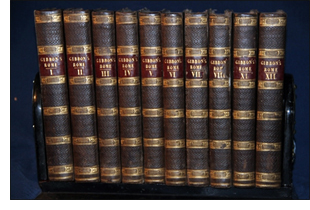featured item
Antique Books
Posted by Gill Jones on 13/11/2013
 In Edmund Wilson’s American Earthquake he tells us that there is no virtue in first additions. He then goes on to tell the reader of a man who, travelling to work each day, would tear out pages from the book he was reading, because in his opinion there was no further use for them once they’d been read. Wilson would go on to say that although collectors might not be too pleased with such actions “…it is easier for a camel to pass through the eye of a needle than for a collector of first editions to enter the Kingdom of Literature.” His point may have been that although you may love collecting books, that doesn’t necessarily mean you love what’s inside them.
In Edmund Wilson’s American Earthquake he tells us that there is no virtue in first additions. He then goes on to tell the reader of a man who, travelling to work each day, would tear out pages from the book he was reading, because in his opinion there was no further use for them once they’d been read. Wilson would go on to say that although collectors might not be too pleased with such actions “…it is easier for a camel to pass through the eye of a needle than for a collector of first editions to enter the Kingdom of Literature.” His point may have been that although you may love collecting books, that doesn’t necessarily mean you love what’s inside them.
There may be many amongst you that feel this is quite a preposterous notion, especially those of you who are avid readers and collectors of rare and fine books. Reading is special and no amount of kindles or ipads can take their place, but reading and collecting books can be two entirely different things. A collection of rare books is hardly likely to be taken down from a shelf and lovingly read for fear of damaging it irreparably, after all, a single first edition could be worth thousands, it can hardly be flicked through casually of an evening, while watching TV. Such books demand great care and attention. We have already covered book cases in an earlier blog and there are some fine furniture pieces out there for those of you who do collect, today however, we are looking at the books themselves.
How do you find them, how do you know if they are worth anything. A few checks may suffice and of course speaking to the shop owner or online dealer before purchase is a good idea. The condition of a book is obviously important as a book that is in tatters, regardless of how old it is, will have little worth. A first edition will always be more valuable than a later one and if it has been signed by the author even better. If you are looking at a book from the 20th century onwards then you must consider whether it has a dust jacket (if it’s a hardcover).
Sometimes there are some rather strange words used by booksellers so if you’ve just started collecting books and you’re starting to feel like you’ve entered the twilight zone, fear not, as there are plenty of glossaries on the internet that can get you started. It might help to familiarise yourself with the lingo first if you’re going to become an avid collector.
On www.antiques.co.uk this week we have a rather excellent History of Cornwall by William Borlase, and yes it’s a first edition. It consists of several essays on Druid Superstition. It’s from 1754 and it’s in excellent condition bound in full brown calf and rebacked with the spine glued back on, which is apparently common with a book of this age. Next, we have a book by Aubrey Beardlsey, the artist, a rare book by Brian Reade. It may not be a first edition, but it is a rare copy of an outstanding artist and is still readable.
And a really magnificent find are two rare Japanese books on Japanese art from textiles to paintings and swords. Contained within are some of the most exquisite cloisonné you are likely to see with breath-taking artwork. They really are amazing and would make any avid book collector a very happy person.
Finally, although there is no year we have a beautiful York Diorrsan histories book. It’s a first edition and it’s beautifully bound in blue. If that doesn’t take your fancy we have a Girls Own Annual from 1902 and over 100 years old and although the cover is slightly worn it’s a beautiful little book and full of memories of another era.
And finally something to hold your collection in, an absolutely stunning antique English Coromandel book box by Howell, James & Co of London dating to around the mid-19th century, (1860). It comes in a dark wood with its own key and could have been used to carry a small collection from one place to another safely.
Collecting your books and keeping them in a box or cabinet may be a safer and more savoury option that Edmund Wilson’s friend who decided to tear each used page from the spine. You may have read your collection, but you may not be ready to dispose of them in such a violent manner just yet.




